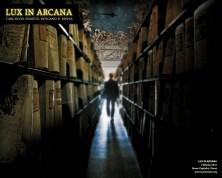
Last month on honeymoon in Rome, my husband and I visited the ‘Lux in Arcana: The Vatican Secret Archives Reveals Itself’ exhibition at the Musei Capitolini.
The exhibition is described as ‘an unique and unrepeatable event’, in which ‘100 original documents, preserved for 400 years in the papal Archives, have crossed the boundaries of Vatican City for the first time ever’ (Musei Capitolini). It runs from February 29th to September 9th 2012.
The catalogue describes the Vatican Archives as:
‘More than twelve centuries of history in eighty-five kilometres of shelves; millions of documents grouped in more than 650 archival folds. This is the Vatican Archives today, as it celebrates the four hundredth anniversary of its foundation by pope Paul V, in 1612, with the exhibition ‘Lux in Arcana – The Vatican Secret Archives Reveal Itself.’ (p.16 Exhibition Catalogue)
When I tried to book tickets for the exhibition in March for either of the two days we were going to spend in Rome, it was sold out. My wonderful Italian colleague phoned the museum and was told that it might be possible to queue for tickets on the day. So that is what we did. We got to the museum about 5pm and managed to get tickets!
As I hadn’t expected to see the exhibition, I had to dash into the museum gift shop to buy a pen and notebook to make notes. The exhibition was very crowded, so we did not get the chance to look at all the items on display.
The exhibition consists of the following rooms:
- A – The Guardian of Memory
- B – Tiara and Crown
- C – In the Conclave’s Secrecy
- D – Reflection and Dialogue
- E – Gold and Ink
- F – Heretics, Crusaders and Knights
- G – Saints, Queens and Courtiers
- H & L – Scientists, Philosophers and Inventors
- P – The Signs of Power
- S – The ‘Closed Period’
L’affare segreto di Enrico VIII
The item we had come to see, ‘A letter from members of the English parliament to pope Clement VII’ is at the far end of room A – The Guardian of Memory.
Entitled ‘L’affare segreto di Enrico VIII’ (Henry VIII’s Secret Matter), the letter with its seals is displayed upright in a large case, so the seals hang down below the letter. It is a most amazing document to view.
You can see it on display at Reuters Blog – FaithWorld
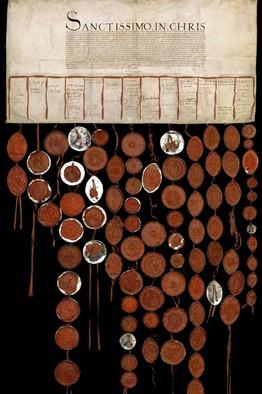
The catalogue describes it as:
‘Parchment bearing 83 signatures (plus one erased), written in 13 columns on the fold, the columns being separated by a red silk ribbon to which 81 pending seals in tin skippets and 4 empty skippets are attached.’ (p.51 Exhibition Catalogue)
It measures 93 x 46 cm and is dated July 13 1530.
‘It was the year 1530. For months the matrimonial case of Henry VIII of England versus Catherine of Aragon had been pending in the hands of pope Clement VII. The King obsessed more than ever by what he called his ‘Secret Matter’, wanted to obtain at all costs the pope’s annulment of his first marriage so that he could marry young Anne Boleyn and hopefully sire the longed-for heir to the throne. It was necessary to step up the pressure on the pope. On June 12th Henry summoned a number of his supporters to court, mostly members of the House of Lords, and asked them to write to Clement VII, urging him to adjudicate the King’s suit by granting him an annulment. A draft of the proposed letter was read out to the meeting, but some of the attendees criticized its overly aggressive tones; it suggested that a council might be summoned to act against the pope if he did not grant Henry’s wish.’
After a few days’ adjournment – perhaps the time needed to redraft the letter – the meeting sat again on June 16th… This time, though, Henry took a shrewder approach. To avoid the risk of further delay, he spoke separately to each member. It was impossible to resist his vehement arguments; that day, the letter received a good number of signatures Henry sought. But the King wasn’t satisfied; the document had to be signed and sealed even by the men who hadn’t been able to come to court. The absentees were reached at their homes by royal commissioners dispatched to every corner of the kingdom. For example, during the night of June 16, the conspicuous parchment was presented to Cardinal Thomas Wolsey at his house at Esher; Wolsey signed it in the space reserved for archbishops and pressed his seal into the wax with which the royal messengers had already filled the skippet assigned him.
The document bearing all its signatures and seals, was dated and dispatched a month later. The signers included nearly 70% of the members of the House of Lords: all of the kingdom’s dukes, marquesses and earls, most of the barons and the abbots in charge of the major abbeys. None of the names could have imagined the fate that would befall some of them a few years later. George Boleyn, viscount of Rochford and brother of the future Queen Anne, was executed with her for high treason, aggravated by the further charge of having committed incest with his sister.’ (p.51, Exhibition Catalogue)
Each item has a multi-media screen with information. The display for this document reads:
‘A letter from members of the English parliament to pope Clement VII’
‘The members of the House of Lords, together with some members of the House of Commons and of the Court, urge pope Clement VII to annul Henry VIII’s marriage to Catherine of Aragon so that the King can remarry legitimately. The authors of this document using a veiled threatening tone allude to the ‘extreme remedies’ they would be willing to pursue were their request be turned down.’ (Musei Capitolini)
All of the rooms were very dimly lit to protect the treasures, which made it difficult to read the signatures. The clearest signature was that of George, Lord Rochford. It was bolder than the others, which were only half readable. According to the exhibition website, George signed the petition ‘on behalf of his father Thomas, who was on a diplomatic mission to Italy.’ (Musei Capitolini)
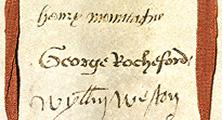
It was the first time that I had seen the handwriting of George Boleyn and seeing all the Tudor signatures was a forcible reminder that these people were real, were flesh and blood, that they had looked at this document as we did and then bent to add their names.
A copy of ‘Henry VIII’s Secret Matter’ is on display in a room towards the end of the exhibition. This is much easier to read as it is displayed flat and I didn’t have to stand on tip toe to look at the signatures!
Other Items
Also included in the exhibition were other items relating to the Tudor period.
In room A was ‘Charles V’s Edict of Worms against Martin Luther’ in 1521.
‘The Imperial ban against the heretic’
‘The Edict of Worms established an imperial ban against Luther and ordered all his writings to be destroyed.’ (p. 35, Exhibition Catalogue)
In Room F – Heretics, Crusaders and Knights was the bull of excommunication itself.
‘The Excommunication of Martin Luther: Leo X’s bull Decet Romanum Pontificen’

‘On 3rd January, 1521, the pope issued a bull titled Decet Romanum Pontificen, in which he excommunicated Luther.’ (p. 120, Exhibition Catalogue).
In Room G – Saints, Queens and Courtiers, there is a letter written by Mary Queen of Scots to the pope on 23rd November 1586.
‘A queen bound for the scaffold’
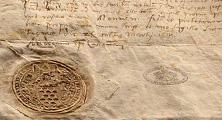
The display for this document reads:
‘Shortly after receiving the announcement of her death sentence Mary Stuart, the exiled queen of Scotland and a prisoner of England for nearly 20 years, writes to Sixtus V to inform him of her imminent end, professing her Catholic faith and recommending her soul to God.’ (Musei Capitolini)
In Room P – The Signs of Power, there was Philip of Spain’s gold seal.
Philip of Spain’s imposing gold seal
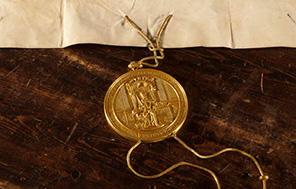
The display reads:
‘The oath of fealty to the Holy See sent to pope Paul IV by Philip in his capacity as prince of Spain, King of England, France and Sicily. Affixed to the document is Philip’s majestic golden seal, which weighs around 800 grams (1.75 pounds). Because of its refined engraving, this seal is among the most precious ones presented in the Vatican Secret Archives.’ (Musei Capitolini)
The exhibition was a wonderful experience that I will never forget. Of all the exhibits, my favourite was ‘L’affare segreto di Enrico VIII’.
The document has been called ‘the most impressive one ever circulated by the Tudors. Its 83 signatures embody the stories of the protagonists and the victims of some of the bloodiest decades in English history.’ (p.51 Exhibition Catalogue)
Thank you to Claire for inviting me to write this article, and thank you to my husband, for carrying two large exhibition catalogues home in his suitcase!
Note from Claire
Thank you so much to Tamise for writing this article and also to her and her husband for bringing me back the exhibition catalogue and posting it to me. Tamise runs a blog on Lady Jane Grey, so do check out her work at The Lady Jane Grey Reference Guide Blog
Sources
- ‘Lux in Arcana: The Vatican Secret Archive Reveals Itself’ Exhibition Catalogue, Palombi & Partner Srl, February 2012
- Lux in Arcana
- Lux in Arcana Documents
- Lux in Arcana – The Concubine’s Brother
- The Wall Street Journal – The Papacy’s Private Papers
- Faith World – Vatican Secret Archives show Galileo signature, Henry VIII letter, Templar scroll
